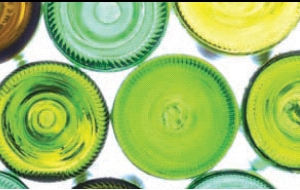Product life cycle: Solutions out of the box
 Products are increasingly being designed, manufactured and packaged with a new focus on the end of their life cycle – and beyond
Products are increasingly being designed, manufactured and packaged with a new focus on the end of their life cycle – and beyondIn this age of overflowing landfills and seas clogged with plastic, businesses are seeing large benefits to their reputations from offering recyclable products with minimised packaging. The entire lifecycle of products, from design and manufacturing to maintenance and eventual disassembly, recycling and reuse, is being re-examined with an eye toward energy efficiency, emission reductions and innovation.
Less is more
Product packaging is a major area where new technologies and innovations are having an impact. Consumers and retailers, including key market influencers like Wal-Mart, are demanding that manufacturers provide reduced and lower impact, recyclable packaging.
Wal-Mart has implemented a packaging scorecard that rates suppliers on their progress. And manufacturers are heeding the call with innovative approaches to both primary and secondary packaging.
The focus for many companies has fallen on reducing the amount of packaging they produce in the first place. Nestlé claims to have reduced packaging materials for its bottled water products by 22% since 1998, saving 257,000 tonnes of waste and helping to reduce its total greenhouse gas emissions by 16%.
Design strength
Global food and homecare brand Unilever has turned to selling more concentrated products to reduce packaging. It introduced a version of its popular all laundry detergent that is three times more concentrated than conventional products. The company says the 32-ounce mini bottle uses 55% less plastic and has eliminated 750 million sq ft of secondary packaging. Unilever can also deliver 200% more product in every truck, saving an estimated 26 million gallons of diesel fuel annually.
UK brewers including SABMiller, Scottish & Newcastle and Frederic Johnson’s, have introduced lightweight bottles to reduce both the amount of materials entering the waste stream and the makers’ carbon emissions. Technological advances in manufacturing have enabled the companies to make bottles with 30% less glass, which uses less energy in both their production and distribution.
Andy Gale, technical manager for beers, wines and spirits at Tesco, says glass is by far the heaviest component of the retailer’s packaging waste. Tesco aims to save 72,000 tonnes of glass per year by 2010 by reducing the weight of at least 25% of the wine bottles it sells.
Plantic growth
Marks & Spencer is turning to more environmentally friendly packaging. The retailer is boxing its Swiss chocolates in an innovative tray from Plantic Technologies made from non-GM, high amylose corn starch. The patented bioplastics technology is an eco-sensitive alternative to petrochemical-based plastic and is biodegradable and made from renewable and sustainable resources. It also has the lowest overall energy requirement for its production (40% less real energy to manufacture) compared with PVC, PET and PLA.
Helene Roberts, head of packaging for M&S, says the company will use Plantic to help meet its goals of reducing packaging by 25% over the next five years.
Recycle and reuse
Manufacturers and retailers are also stepping up efforts to help consumers recycle more.
Coca-Cola has committed heavily to recycling and says it envisages a world where its packaging is no longer seen as waste, but as a valued resource. The company has pledged to recycle 100% of its aluminum cans sold in the US, which it says requires 95% less energy than creating aluminum from raw materials and reduces carbon emissions by 95%.
A similar approach is being taken by Patagonia, the US recreational clothing manufacturer, through its Common Threads Garment Recycling programme. Using Ecocircle recycling technology from Teijin, a progressive fabric manufacturer in Japan, Patagonia is collecting and recycling used Capilene garments and breaking them down to make new polyester fibres.
Because traditional polyester is made from petroleum, Patagonia says using recycled fibres greatly reduces the fossil fuel-based inputs needed in the manufacturing process. The company’s chief executive, Casey Sheahan, says Patagonia hopes to “expand the world view of recycling beyond just cans, newspapers and bottles” and make clothing a recyclable resource.
Driven to innovate
Car manufacturer Chrysler has found one of the most innovative strategies around. Its two St. Louis assembly plants, which typically sent about one million pounds of dried paint solids to landfills each year, are now shuttling the waste to a nearby electric utility which burns the solids to generate electricity.
The paint solids currently replace about 570 tonnes of coal a year and generate enough electricity for 70 homes for residents and businesses of St. Louis.
Other companies, including Honda, are committing to ‘zero waste to landfill’ strategies from their factories.
For example, by developing a device to remove foreign matter from incineration ash, the company has been able to turn 2,100 tonnes of ash previously sent to landfills annually into material for cement or other paving materials. Honda is pursuing similar programmes at its other manufacturing facilities around the world.
A healthy start
Although many of these advances are restricted to pilot projects, they are proof of an increasing awareness among businesses and consumers of the importance of conserving resources, says Alan Knight, an independent advisor to businesses and the UK government on greening retail and supply chains.
Knight believes significant progress in greening products relies on government action through legislation and regulation. Although legal and regulatory action is often viewed negatively by business, he says, it will level the playing field for companies.
“The good news”, says Knight, “is that unlike several years ago when most companies had little to no awareness or interest in the downstream impacts of their products, now companies are aware and willing, if not eager, to at least begin a dialogue on improving their environmental footprint.”
Useful links:
www.envirowise.gov.uk
www.plantic.com.au
www.wrap.org.uk

